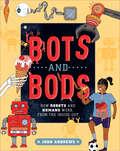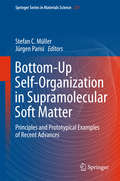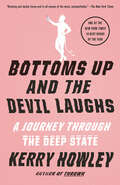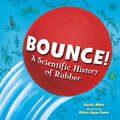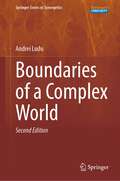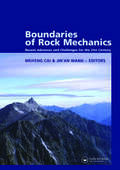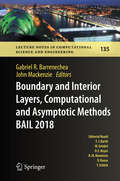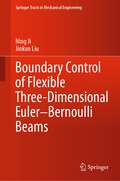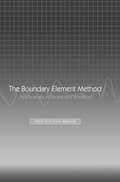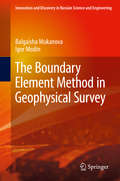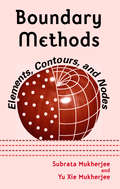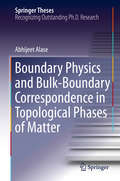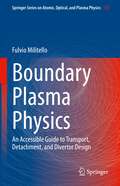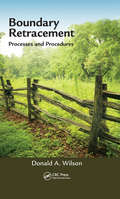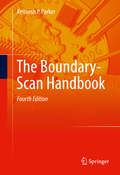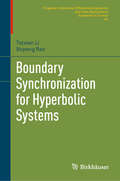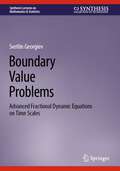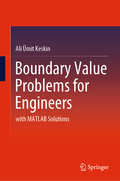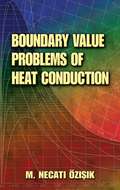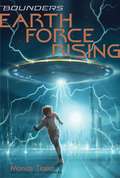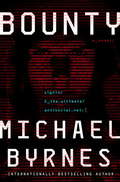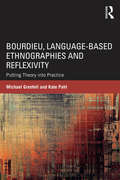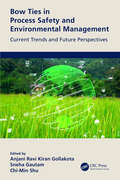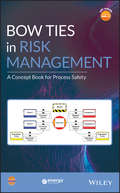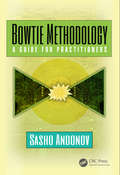- Table View
- List View
Bots and Bods: How Robots and Humans Work, from the Inside Out
by John AndrewsBots and Bods is an illustrated guide for kids looking to explore anatomy and technology and how they're related. How do we both move or sense the world? How does robot intelligence compare to our own? Middle-grade readers will find these answers and more among the four sections:Body structuresMuscle and movementSenses and sensorsThinking and feelingAn accessible guide with exciting illustrations, fun facts, and special feature spreads about robots in the real world explains why &“bots&” can sometimes do a better job than &“bods&” and vice versa.
Bottom-Up Self-Organization in Supramolecular Soft Matter: Principles and Prototypical Examples of Recent Advances (Springer Series in Materials Science #217)
by Stefan C. Müller Jürgen ParisiThis book presents the general concepts of self-organized spatio-temporal ordering processes. These concepts are demonstrated via prototypical examples of recent advances in materials science. Particular emphasis is on nano scale soft matter in physics, chemistry, biology and biomedicine. The questions addressed embrace a broad spectrum of complex nonlinear phenomena, ranging from self-assembling near the thermodynamical equilibrium to dissipative structure formation far from equilibrium. Their mutual interplay gives rise to increasing degrees of hierarchical order. Analogues are pointed out, differences characterized and efforts are made to reveal common features in the mechanistic description of those phenomena.
Bottoms Up and the Devil Laughs: A Journey Through the Deep State
by Kerry HowleyA NATIONAL BOOK CRITICS CIRCLE AWARD FINALIST • A NEW YORK TIMES TOP TEN BOOK OF THE YEAR • A VANITY FAIR BEST BOOK OF THE YEAR&“Riveting and darkly funny and in all senses of the word, unclassifiable.&” – The New York TimesA wild, humane, and hilarious meditation on post-privacy America—from the acclaimed author of ThrownWho are you? You are data about data. You are a map of connections—a culmination of everything you have ever posted, searched, emailed, liked, and followed. In this groundbreaking work of narrative nonfiction, Kerry Howley investigates the curious implications of living in the age of the indelible. Bottoms Up and the Devil Laughs tells the true story of intelligence specialist Reality Winner, a lone young woman who stuffs a state secret under her skirt and trusts the wrong people to help. After printing five pages of dangerous information she was never supposed to see, Winner finds herself at the mercy of forces more invasive than she could have possibly imagined.Following Winner&’s unlikely journey from rural Texas to a federal courtroom, Howley maps a hidden world, drawing in John Walker Lindh, Lady Gaga, Edward Snowden, a rescue dog named Outlaw Babyface Nelson, and a mother who will do whatever it takes to get her daughter out of jail. Howley&’s subjects face a challenge new to history: they are imprisoned by their past selves, trapped for as long as the Internet endures. A soap opera set in the deep state, Bottoms Up and the Devil Laughs is a free fall into a world where everything is recorded and nothing is sacred, from a singular writer unafraid to ask essential questions about the strangeness of modern life.
Bounce!: A Scientific History of Rubber
by Sarah AlbeeEver wondered what makes rubber bounce? Or why it's stretchy? And WHY is rubber so . . . rubbery?! Learn the facinating science and history behind this ubiquitous material!With sidebars, graphics, fun facts, and more, the history of rubber reveals plenty of fascinating secrets and surprises. Elementary school readers will discover that early balls didn't bounce; that people in the rainforest made waterproof gear from rubber thousands of years before Europeans got into the act; and that sneakers, bicycles, and cars created demand for more and more rubber!Back matter includes a time line and a bit about the complicated implications of harvesting rubber.
Boundaries of a Complex World (Springer Series in Synergetics)
by Andrei LuduThe 2nd edition of this book provides novel topics and studyies in boundaries of networks and Big Data Systems.The central theme of this book is the extent to which the structure of the free dynamical boundaries of a system controls the evolution of the system as a whole. Applying three orthogonal types of thinking - mathematical, constructivist and morphological, it illustrates these concepts using applications to selected problems from the social and life sciences, as well as economics. In a broader context, it introduces and reviews some modern mathematical approaches to the science of complex systems. Standard modeling approaches (based on non-linear differential equations, dynamic systems, graph theory, cellular automata, stochastic processes, or information theory) are suitable for studying local problems. However they cannot simultaneously take into account all the different facets and phenomena of a complex system, and new approaches are required to solve the challenging problem of correlations between phenomena at different levels and hierarchies, their self-organization and memory-evolutive aspects, the growth of additional structures and are ultimately required to explain why and how such complex systems can display both robustness and flexibility. This graduate-level text addresses a broader interdisciplinary audience, keeping the mathematical level essentially uniform throughout the book, and involving only basic elements from calculus, algebra, geometry and systems theory.
Boundaries of Rock Mechanics: Recent Advances and Challenges for the 21st Century
by Meifeng Cai Jin’an WangBoundaries of Rock Mechanics. Recent Advances and Challenges for the 21st Century contains 180 papers from the International Young Scholars Symposium on Rock Mechanics 2008 (Beijing, China, 28 April-2 May 2008). The symposium was organized by the ISRM Commission on Education, and sponsored by the International Society for Rock Mechanics (ISRM) and
Boundary and Interior Layers, Computational and Asymptotic Methods BAIL 2018 (Lecture Notes in Computational Science and Engineering #135)
by Gabriel R. Barrenechea John MackenzieThis volume gathers papers presented at the international conference BAIL, which was held at the University of Strathclyde, Scotland from the 14th to the 22nd of June 2018. The conference gathered specialists in the asymptotic and numerical analysis of problems which exhibit layers and interfaces. Covering a wide range of topics and sharing a wealth of insights, the papers in this volume provide an overview of the latest research into the theory and numerical approximation of problems involving boundary and interior layers.
Boundary Control of Flexible Three-Dimensional Euler–Bernoulli Beams (Springer Tracts in Mechanical Engineering)
by Ning Ji Jinkun LiuThis book focuses on vibration suppression of flexible three-dimensional Euler–Bernoulli beams modeled by PDEs. Boundary control strategy and several control methods are proposed to stabilize the closed-loop system. Besides, some common engineering problems such as input constraint and output constraint are also considered in the control scheme design. This book offers a comprehensive introduction of the modeling process, controller design, stability analysis and numerical simulation. The detailed MATLAB codes in each chapter are also provided, which can make readers better understand the control flow of the system. This book is mainly targeted for researchers, senior undergraduate students and postgraduate students in the field of control theory and control engineering.
The Boundary Element Method: Applications in Sound and Vibration
by A. Ali C. RajakumarThe Boundary Element Method, or BEM, is a powerful numerical analysis tool with particular advantages over other analytical methods. With research in this area increasing rapidly and more uses for the method appearing, this timely book provides a full chronological review of all techniques that have been proposed so far, covering not only the funda
The Boundary Element Method in Geophysical Survey
by Balgaisha Mukanova Igor ModinThis volume is devoted to the application of the integral equations method (IEM) and boundary elements method (BEM) to problems involving the sounding of geological media using direct current (DC). Adaptive mesh generation algorithms and numerical methods for solving a system of integral equations are discussed. Integral equations for the media, which contains piecewise linear contact boundaries, immersed local inclusions, and subsurface relief, are derived and solved numerically. Both 2.5D and 3D models with ground surface relief are considered. For 2D conductivity distributions, the influence of the relief on the interpretation of results is shown. Search solutions of the direct problem with ground surface relief are compared using the appropriate interpretation of results based on different inversion programs.
Boundary Methods: Elements, Contours, and Nodes (Mechanical Engineering)
by Subrata Mukherjee Yu Xie MukherjeeBoundary Methods: Elements, Contours, and Nodes presents the results of cutting-edge research in boundary-based mesh-free methods. These methods combine the dimensionality advantage of the boundary element method with the ease of discretization of mesh-free methods, both of which, for some problems, hold distinct advantages over the finite element
Boundary Physics and Bulk-Boundary Correspondence in Topological Phases of Matter (Springer Theses)
by Abhijeet AlaseThis thesis extends our understanding of systems of independent electrons by developing a generalization of Bloch’s Theorem which is applicable whenever translational symmetry is broken solely due to arbitrary boundary conditions. The thesis begins with a historical overview of topological condensed matter physics, placing the work in context, before introducing the generalized form of Bloch's Theorem. A cornerstone of electronic band structure and transport theory in crystalline matter, Bloch's Theorem is generalized via a reformulation of the diagonalization problem in terms of corner-modified block-Toeplitz matrices and, physically, by allowing the crystal momentum to take complex values. This formulation provides exact expressions for all the energy eigenvalues and eigenstates of the single-particle Hamiltonian. By precisely capturing the interplay between bulk and boundary properties, this affords an exact analysis of several prototypical models relevant to symmetry-protected topological phases of matter, including a characterization of zero-energy localized boundary excitations in both topological insulators and superconductors. Notably, in combination with suitable matrix factorization techniques, the generalized Bloch Hamiltonian is also shown to provide a natural starting point for a unified derivation of bulk-boundary correspondence for all symmetry classes in one dimension.
Boundary Plasma Physics: An Accessible Guide to Transport, Detachment, and Divertor Design (Springer Series on Atomic, Optical, and Plasma Physics #123)
by Fulvio MilitelloThis book serves as an introduction to boundary plasma physics, providing an accessible entry point to the topic of plasma exhaust in magnetic confinement devices. While it delivers a concise, rigorous, and comprehensive account of all the major scientific topics relevant to those working on the subject, it also remains accessible and easy to consult due to its modular and compact structure. Beginning with the basic kinetic and fluid descriptions of plasma, and advancing through plasma-surface interactions, filamentary transport and plasma detachment, to conclude with a discussion of divertor configurations, this book represents a necessary and timely addition to the literature on the fast-growing field of boundary plasma physics. It will appeal to experienced theoreticians or experimentalists looking to enter the field as well as graduate students wishing to learn about it.
Boundary Retracement: Processes and Procedures
by Donald A. WilsonThe survey and the transference are the distinctive and operative acts in the transmission of real property and, where they differ from each other, one must of necessity control the other. This book addresses the aforementioned concepts by external explanations in order to understand the discrepancies between them. It also helps to avoid expensive and wasteful litigation over boundaries that were previously not in conflict. The text offers an extensive review of the law for boundary retracement and cites numerous case examples.
The Boundary-Scan Handbook
by Kenneth P. ParkerAimed at electronics industry professionals, this 4th edition of the Boundary Scan Handbook describes recent changes to the IEEE1149. 1 Standard Test Access Port and Boundary-Scan Architecture. This updated edition features new chapters on the possible effects of the changes on the work of the practicing test engineers and the new 1149. 8. 1 standard. Anyone needing to understand the basics of boundary scan and its practical industrial implementation will need this book. Provides an overview of the recent changes to the 1149. 1 standard and the effect of the changes on the work of test engineers; Explains the new IEEE 1149. 8. 1 subsidiary standard and applications; Describes the latest updates on the supplementary IEEE testing standards. In particular, addresses: IEEE Std 1149. 1 Digital Boundary-Scan IEEE Std 1149. 4 Analog Boundary-Scan IEEE Std 1149. 6 Advanced I/O Testing IEEE Std 1149. 8. 1 Passive Component Testing IEEE Std 1149. 1-2013 The 2013 Revision of 114 9. 1IEEE Std 1532 In-System Configuration IEEE Std 1149. 6-2015 The 2015 Revision of 1149. 6
Boundary Synchronization for Hyperbolic Systems (Progress in Nonlinear Differential Equations and Their Applications #94)
by Tatsien Li Bopeng RaoWithin this carefully presented monograph, the authors extend the universal phenomenon of synchronization from finite-dimensional dynamical systems of ordinary differential equations (ODEs) to infinite-dimensional dynamical systems of partial differential equations (PDEs). By combining synchronization with controllability, they introduce the study of synchronization to the field of control and add new perspectives to the investigation of synchronization for systems of PDEs. With a focus on synchronization for a coupled system of wave equations, the text is divided into three parts corresponding to Dirichlet, Neumann, and coupled Robin boundary controls. Each part is then subdivided into chapters detailing exact boundary synchronization and approximate boundary synchronization, respectively. The core intention is to give artificial intervention to the evolution of state variables through appropriate boundary controls for realizing the synchronization in a finite time, creating a novel viewpoint into the investigation of synchronization for systems of partial differential equations, and revealing some essentially dissimilar characteristics from systems of ordinary differential equations. Primarily aimed at researchers and graduate students of applied mathematics and applied sciences, this text will particularly appeal to those interested in applied PDEs and control theory for distributed parameter systems.
Boundary Value Problems: Advanced Fractional Dynamic Equations on Time Scales (Synthesis Lectures on Mathematics & Statistics)
by Svetlin GeorgievThis book explores boundary value problems for fractional dynamic equations on arbitrary time scales, including Caputo fractional dynamic equations, impulsive Caputo fractional dynamic equations, and impulsive Riemann-Liouville fractional dynamic equations. The author provides an introduction to each fractional dynamic equation before delving into the problems. The book also covers initial value problems, boundary value problems, initial boundary value problems for each type of equation. The author provides integral representations of the solutions and proves the existence and uniqueness of the solutions.
Boundary Value Problems for Engineers: with MATLAB Solutions
by Ali Ümit KeskinThis book is designed to supplement standard texts and teaching material in the areas of differential equations in engineering such as in Electrical ,Mechanical and Biomedical engineering. Emphasis is placed on the Boundary Value Problems that are often met in these fields.This keeps the the spectrum of the book rather focussed .The book has basically emerged from the need in the authors lectures on “Advanced Numerical Methods in Biomedical Engineering” at Yeditepe University and it is aimed to assist the students in solving general and application specific problems in Science and Engineering at upper-undergraduate and graduate level.Majority of the problems given in this book are self-contained and have varying levels of difficulty to encourage the student. Problems that deal with MATLAB simulations are particularly intended to guide the student to understand the nature and demystify theoretical aspects of these problems. Relevant references are included at the end of each chapter. Here one will also find large number of software that supplements this book in the form of MATLAB script (.m files). The name of the files used for the solution of a problem are indicated at the end of each corresponding problem statement.There are also some exercises left to students as homework assignments in the book. An outstanding feature of the book is the large number and variety of the solved problems that are included in it. Some of these problems can be found relatively simple, while others are more challenging and used for research projects. All solutions to the problems and script files included in the book have been tested using recent MATLAB software.The features and the content of this book will be most useful to the students studying in Engineering fields, at different levels of their education (upper undergraduate-graduate).
Boundary Value Problems of Heat Conduction (Dover Books on Engineering)
by M. Necati OzisikIntended for first-year graduate courses in heat transfer, this volume includes topics relevant to chemical and nuclear engineering and aerospace engineering. The systematic and comprehensive treatment employs modern mathematical methods of solving problems in heat conduction and diffusion. Starting with precise coverage of heat flux as a vector, derivation of the conduction equations, integral-transform technique, and coordinate transformations, the text advances to problem characteristics peculiar to Cartesian, cylindrical, and spherical coordinates; application of Duhamel's method; solution of heat-conduction problems; and the integral method of solution of nonlinear conduction problems. Additional topics include useful transformations in the solution of nonlinear boundary value problems of heat conduction; numerical techniques such as the finite differences and the Monte Carlo method; and anisotropic solids in relation to resistivity and conductivity tensors. Illustrative examples and problems amplify the text, which is supplemented by helpful appendixes.
Bounders
by Monica TeslerIn the tradition of Michael Vey and The Unwanteds, twelve-year-old Jasper and his friends are forced to go up against an alien society in this first book in a brand-new adventure series!Thirteen years ago, Earth Force--a space-military agency--discovered a connection between brain structure and space travel. Now they've brought together the first team of cadets, called Bounders, to be trained as high-level astronauts. Twelve-year-old Jasper is part of this team being sent out into space. After being bullied back on Earth, Jasper is thrilled to have something new and different to do with other kids who are more like him. While learning all about the new technologies and taking classes in mobility--otherwise known as flying with jetpacks--Jasper befriends the four other students in his pod and finally feels like he has found his place in the world. But then Jasper and his new friends learn that they haven't been told everything about Earth Force. They weren't brought to space for astronaut training, but to learn a new, highly classified brain-sync technology that allows them to manipulate matter and quantum bound, or teleport. And it isn't long before they find out this new technology was actually stolen from an alien society. When Jasper and his friends discover the truth about why Earth Force needs them, they are faced with a choice: rebel against the academy that brought them together, or fulfill their duty and protect the planet at all costs.
Bounty: A Novel
by Michael ByrnesRelentlessly suspenseful and disturbingly timely, Bounty summons a chilling vision of our Internet culture gone mad, where freedom, privacy, and the rule of law are demolished by a crisis of nightmare proportions--and the future of justice lies in the hands not of the bravest but the most brutal. When a notorious Wall Street vulture is executed in his high-rise office by a sniper's bullet, it's the kill shot heard around the world. Welcome to Bounty4Justice.com, a rogue website for vigilante assassins, where outraged citizens bid up bounties on corporate crooks and corrupt elites. As the number of targets soars, amateur bounty hunters and professional hit men compete to exterminate the condemned, "proof-of-death" videos become Internet sensations, and the self-styled Robin Hood pulling the strings threatens to plunge the international community into anarchy. Along with other law enforcement agencies across the globe, the FBI and its agents on the case--led by Roman Novak and Rosemary Michaels--are desperately seeking a way to outmaneuver and overpower an all-but-invisible adversary with millions of dollars at its disposal and the ability to cripple the most sophisticated attackers with a keystroke. Following a black-hat hacker extraordinaire down a rabbit hole of firewalls, encryption, and unbreakable codes leads Novak and Michaels into the virtual underworld of the darknet--a seemingly impenetrable haven for the illicit and illegal where Bounty4Justice's mastermind is almost certainly hiding. But just when the agents think they are close to breaching their quarry's digital fortress, they find themselves stalked by an army of cyber outlaws out for blood.Advance praise for Bounty "[Michael] Byrnes fuses science fiction and espionage in this smart, near-futuristic dystopic thriller. . . . The action-packed story line is full of plot twists and explores such topical matters as cyberterrorism and hacktivism. Byrnes raises some serious questions about humankind's increasing dependence on--and assimilation with--the digital world."--Publishers Weekly "Vigilantism goes viral in this thriller about a website that pays bounties for the killing of unpunished child abusers, financial scammers, human rights violators, and other bad actors. . . . Charles Bronson's Death Wish meets the Internet."--Kirkus Reviews "This is a grand-scale spin on the vigilante story. . . . Byrnes's vigilante offers a twist on the theme: he's mastered cyberspace to the point where he can outsource some of his to-do list, offering a cash reward on his website to anyone who will kill the crooked banker . . . and the weasel who bilked Medicare for $127 million. And he's just getting started."--BooklistFrom the Hardcover edition.
Bourdieu, Language-based Ethnographies and Reflexivity: Putting Theory into Practice
by Michael Grenfell Kate PahlOffering a unique and original perspective on Bourdieu, language-based ethnographies,and reflexivity, this volume provides a nuanced, in-depth discussion of the complex relationship between these interconnected topics and their impact in real-world contexts. Part I opens the book with an overview of the historical background and development of language-based ethnographic research and Bourdieu’s work in this space. Part II presents a series of case studies that highlight a Bourdieusian perspective and demonstrate how reflexivity impacts language-based ethnography. In each study, Bourdieu’s conceptual framework of reflexively-informed objectivity examines the ways in which the studies themselves were constructed and understood. Building on Parts I and II, the concluding set of chapters in Part III unpacks the messiness of the theory and practice of language-based ethnography, and provides insights into what reflexivity means for Bourdieu and in practical contexts. Arguing for a greater reflexive understanding in research practice, this volume sets an agenda for future literacy and language research.
Bow Ties in Process Safety and Environmental Management: Current Trends and Future Perspectives
by Anjani Ravi Kiran Gollakota Sneha Gautam Chi-Min ShuBow Ties in Process Safety and Environmental Management: Current Trends and Future Perspectives aims to combine the process safety aspects and the potential dangers to the ecology including the source of the contamination, and especially, the unbalanced utilization of toxic chemicals in process industries. It also covers a broad spectrum of industrial process safety, environmental pollution factors, dangers to land, water, air and living species, remediation technologies (traditional and futuristic approaches), pollutant degradation through numerical modelling, and physicochemical characteristics of the chemicals and their thermal analysis. It also provides the mandated safety data sheets already available and suggestions for the improvement of industrial specifications. Discusses detailed aspects of process safety and environmental impact from a theoretical and practical perspective Covers detailed procedures of environmental modeling concepts Explores forensic investigation sequences during the incident Proposes futuristic approaches towards risk assessment and management Includes real-time case studies with complexities and solutions This book is written for researchers, graduate students, and professionals involved in Chemical Engineering, Environmental Engineering, and Process Safety Engineering.
Bow Ties in Risk Management: A Concept Book for Process Safety
by CcpsFrom a collaborative effort of the Center for Chemical Process Safety (CCPS) and the Energy Institute (EI) comes an invaluable book that puts the focus on a specific qualitative risk management methodology – bow tie barrier analysis. The book contains practical advice for conducting an effective bow tie analysis and offers guidance for creating bow tie diagrams for process safety and risk management. Bow Ties in Risk Management clearly shows how bow tie analysis and diagrams fit into an overall process safety and risk management framework. Implementing the methods outlined in this book will improve the quality of bow tie analysis and bow tie diagrams across an organization and the industry.
Bowtie Methodology: A Guide for Practitioners (Developments in Quality and Safety)
by Sasho AndonovBow Tie Methodology (BTM) consists of two methods, Fault Tree Analysis (FTA) and Event Tree Analysis (ETA), which are connected by a single event. The methodology is holistic and provides the tools and pre-event analysis, which is also called the risk calculations, and post-event analysis, also called the risk mitigations, of quality and safety related events. There are plenty of articles or chapters on this methodology, however there is no book that covers everything in one place. The book is filled with examples taken from the aviation industry and elaborates theory implemented in practice, which gives quality and safety practitioners a guidance on how to use and apply BTM in practice.
